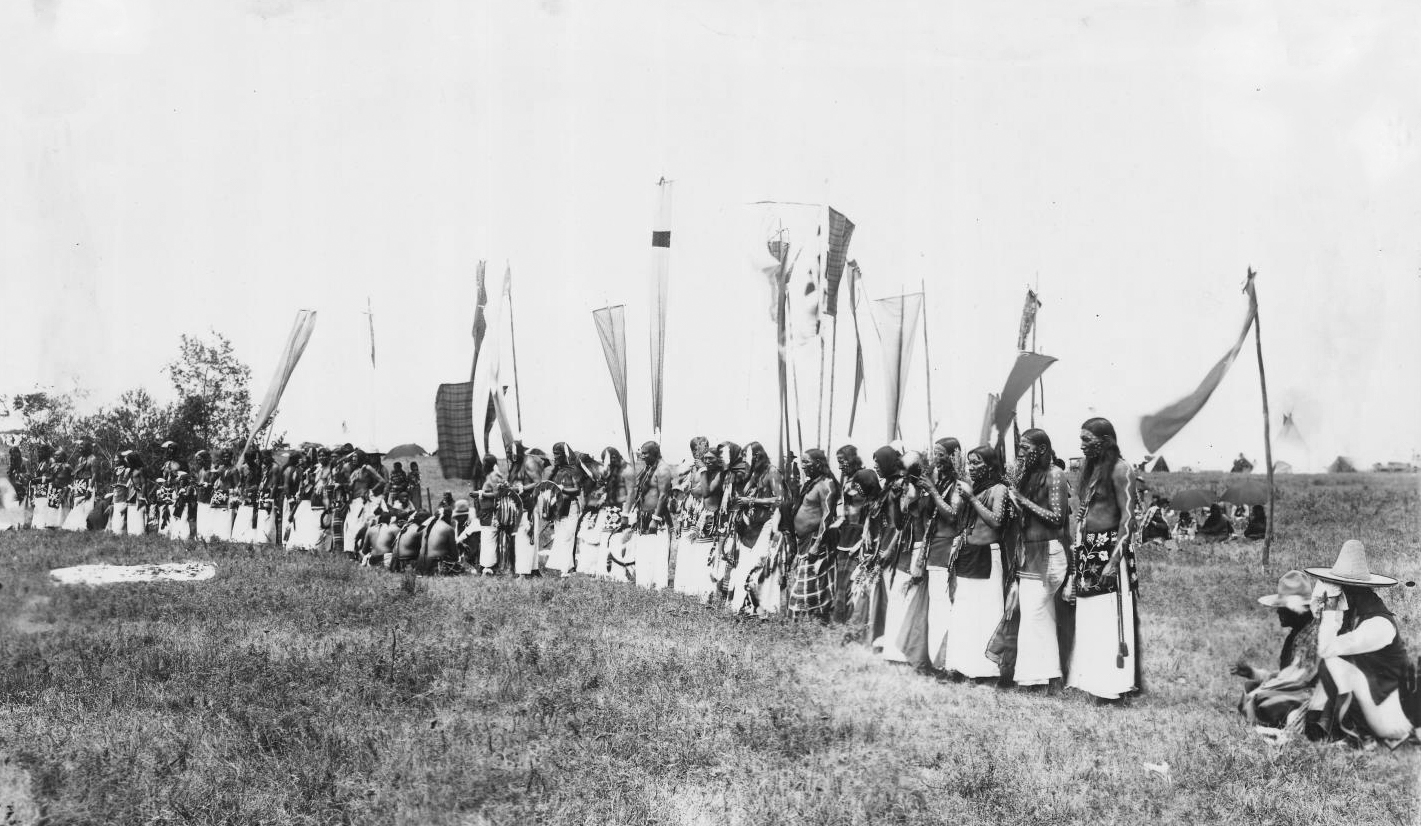
The Encyclopedia of Oklahoma History and Culture
MILITARY SOCIETIES, AMERICAN INDIAN.
Competition and social powwows have become an integral and important part of American Indian life in Oklahoma. These gatherings feature several styles of dancing and are held almost on a weekly basis throughout the state. Although familiar with American Indian dancing and powwows, most non-Indian Oklahomans are not aware of the fact that most of the men's dances are directly descended from the military society ceremonies of groups such as the Kiowa, Comanche, Plains Apache, Otoe, Cheyenne, Arapaho, Pawnee, Osage, and Ponca.
In actuality, "military society" is something of a misnomer. Practically every American Indian tribe had within its social and political structure both men's and women's sodalities, which could be roughly defined as clubs or associations that had some corporate purpose. There were religious sodalities, men's "work" groups that prepared fields for planting, women's craft guilds, boy's dance societies, and even associations of elderly women who, as among the Kiowa, were appealed to for special prayers when young men went to war. Active among several tribes in Oklahoma, today's War Mother societies are very likely the direct descendants of the latter groups.
Men's societies primarily acted as police forces during the annual Sun Dance ceremony and the great summer buffalo hunts, while villages were on the move to better hunting grounds or water supply, or when large meetings took place. These associations also conducted their special ceremonies during these gatherings and in so doing entertained the people and reaffirmed the tribal virtues of generosity, courage, and honesty. In the historic period U.S. Army troops often called these ceremonies "scout dances" simply because they observed the dances that members of the Indian Scouting Corps conducted. These were, however, "scout dances" in the literal sense, because the dances themselves enacted the duties of a scout: finding game and being on the lookout for enemies. Symbolically, they emphasized courage and absolute reliability, for a scout could not lie, because the very lives of the people depended on his integrity.
The martial orientation of the various men's sodalities increased as Euroamerican expansion displaced eastern tribes, which, in turn, intensified warfare on the prairies and plains. Military societies rarely fought as tactical units such as squads, companies, or regiments. Some, however, did serve tactical purposes. For example, a few particularly designated societies served as "rear guards" if a village was forced to flee from an enemy onslaught. These units also prepared their members for battle and performed rituals that honored or purified veterans of combat. Some associations required members to vow not to retreat in battle, and across their chests the men wore special bandoliers that would be attached to a lance driven into the ground during combat. Once "staked," the men could not leave the field unless another society member either told them to do so or physically pulled the lance from the ground.
Practically every men's society had its own special regalia or weaponry. Group leaders often kept the sodality's bundles of sacred objects or "medicine" that had to be ritually tended. In some associations, members carried lances, "coup sticks," bows, or war clubs of specialized design or color that could be easily recognized as belonging to that particular unit in the heat of battle. A warrior might wear a feather or combination of feathers, an animal skin, paint their bodies and faces in a special way, or wear certain clothing particular to his society. The Kiowa Black Leggings, for example, wore black leggings or painted their legs from the knee down in the same color. Members of the Black Leggings often wore red capes symbolizing the battles with red-caped Mexican cavalry troops.
All of these societies were severely repressed after the wars with the Americans. Some of the dances were revived in the early 1900s to be reenacted in the Wild West shows of Pawnee Bill and the 101 Ranch. In that way, many of the songs associated with the men's dances of the Ponca, Pawnee, Otoe, Missouri, Kaw, and Osage nations were preserved. After World War II veterans from these tribes as well as from the Kiowa, Comanche, Apache, Cheyenne, and Arapaho nations revived several of their own military societies in honor of the participation of American Indians in every American war effort since World War I. Perhaps the most widespread of these ceremonies is the tiah-pia or gourd dance, which had its origins among the Kiowa people. It has become the preliminary ceremony to nearly every American Indian powwow in Oklahoma and throughout the Southwest. Special men's dances or heyluska ceremonies continue today among the Ponca, Pawnee, Otoe, and Osage nations.
See Also
AMERICAN INDIANS, DANCE–AMERICAN INDIAN, CODE TALKERS, GHOST DANCE, POWWOWS, SUN DANCE






